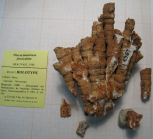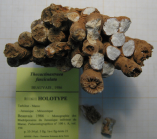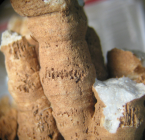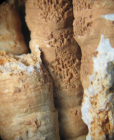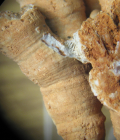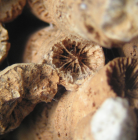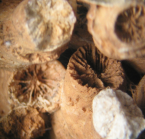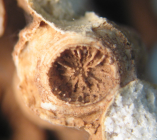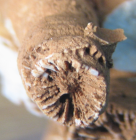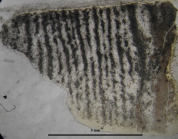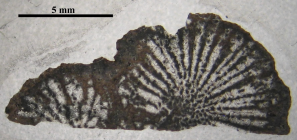Scleractinia taxon details
Thecactinastraea L. Beauvais, 1986 †
1455180 (urn:lsid:marinespecies.org:taxname:1455180)
accepted
Genus
Thecactinastraea fasciculata L. Beauvais, 1986 † (type by original designation)
marine, fresh, terrestrial
fossil only
Beauvais L. (1986). Monographie des madréporaires du Jurassique inférieur du Maroc. <em>Palaeontographica (A).</em> 194 (1/3): 1–68. [details]
Description Phaceloid corallum with subcylindrical corallites covered with an epitheca showing regular growth rings and finer...
Description Phaceloid corallum with subcylindrical corallites covered with an epitheca showing regular growth rings and finer striation. costae. Corallite outline subcircular to distorted after the intracalicular budding, cutting calicular edge. Radial elements compact, free, attenuated, straight. Distal edge with regular teeth, inner edge with detached trabeculae producing a papillose columella, lateral faces possibly with mi-pennules, Microstructure not known. Hexameral symmetry probable, bilateral symmetry poorly developed. Endotheca made of dissepiments straightened near the wall and sloping down to the center, columella papillose, peripheric wall whose the nature is difficult to precise. Very small vertical striation suggesting a trabecular nature. [details]
Hoeksema, B. W.; Cairns, S. (2025). World List of Scleractinia. Thecactinastraea L. Beauvais, 1986 †. Accessed at: https://www.marinespecies.org/scleractinia/aphia.php?p=taxdetails&id=1455180 on 2025-05-13
Date
action
by
original description
Beauvais L. (1986). Monographie des madréporaires du Jurassique inférieur du Maroc. <em>Palaeontographica (A).</em> 194 (1/3): 1–68. [details]
basis of record Melnikova GK, Roniewicz E. (2017). Early Jurassic corals with dominating solitary growth forms from the Kasamurg Mountains, Central Asia. <em>Palaeoworld.</em> 26 (1): 124-148., available online at https://doi.org/10.1016/j.palwor.2016.01.001 [details]
basis of record Melnikova GK, Roniewicz E. (2017). Early Jurassic corals with dominating solitary growth forms from the Kasamurg Mountains, Central Asia. <em>Palaeoworld.</em> 26 (1): 124-148., available online at https://doi.org/10.1016/j.palwor.2016.01.001 [details]
 Present
Present  Inaccurate
Inaccurate  Introduced: alien
Introduced: alien  Containing type locality
Containing type locality
From editor or global species database
Comparison Thecactinastraea differs from Phacelophyllia because of its free septa. [details]Description Phaceloid corallum with subcylindrical corallites covered with an epitheca showing regular growth rings and finer striation. costae. Corallite outline subcircular to distorted after the intracalicular budding, cutting calicular edge. Radial elements compact, free, attenuated, straight. Distal edge with regular teeth, inner edge with detached trabeculae producing a papillose columella, lateral faces possibly with mi-pennules, Microstructure not known. Hexameral symmetry probable, bilateral symmetry poorly developed. Endotheca made of dissepiments straightened near the wall and sloping down to the center, columella papillose, peripheric wall whose the nature is difficult to precise. Very small vertical striation suggesting a trabecular nature. [details]
Remark Two nominal species. [details]
